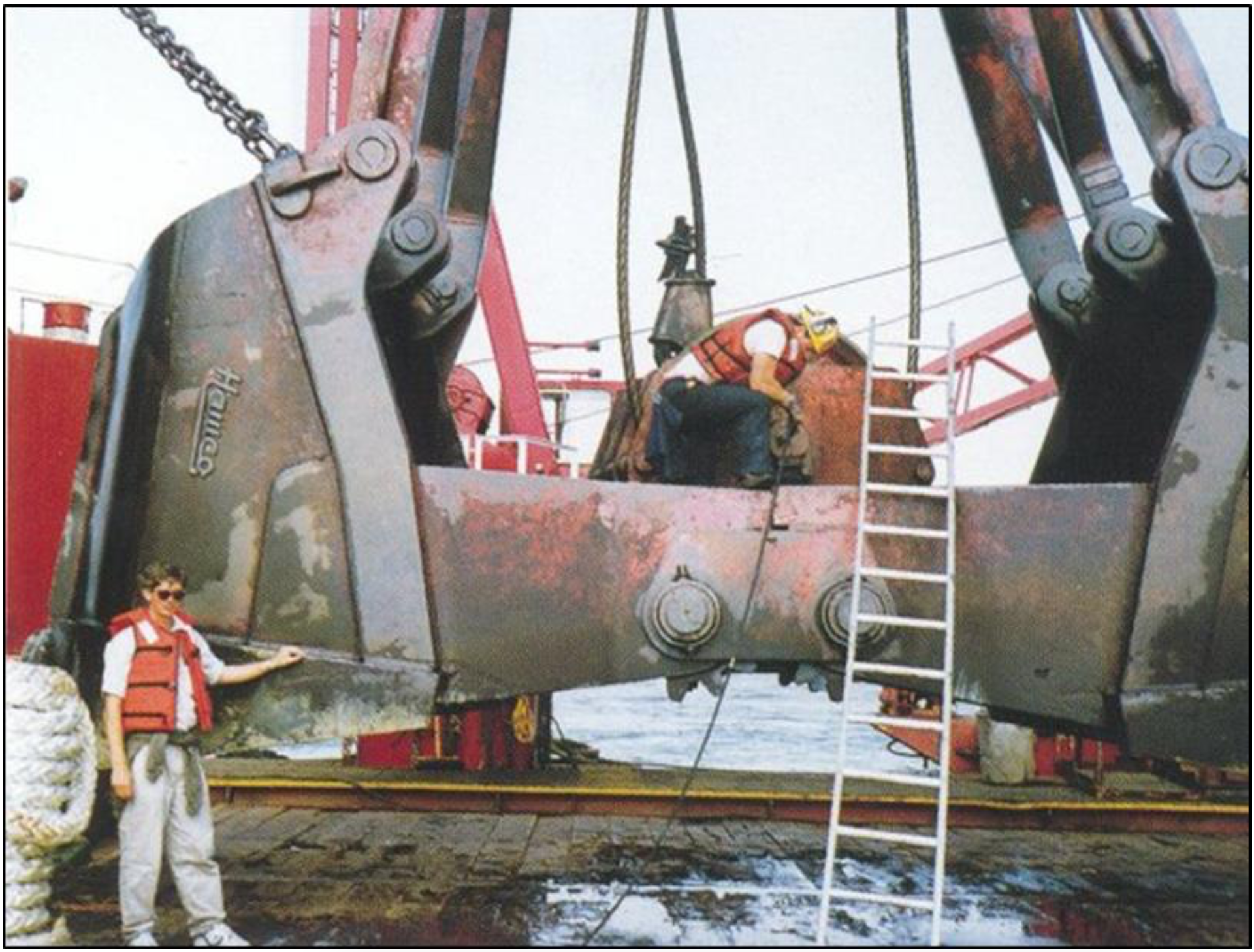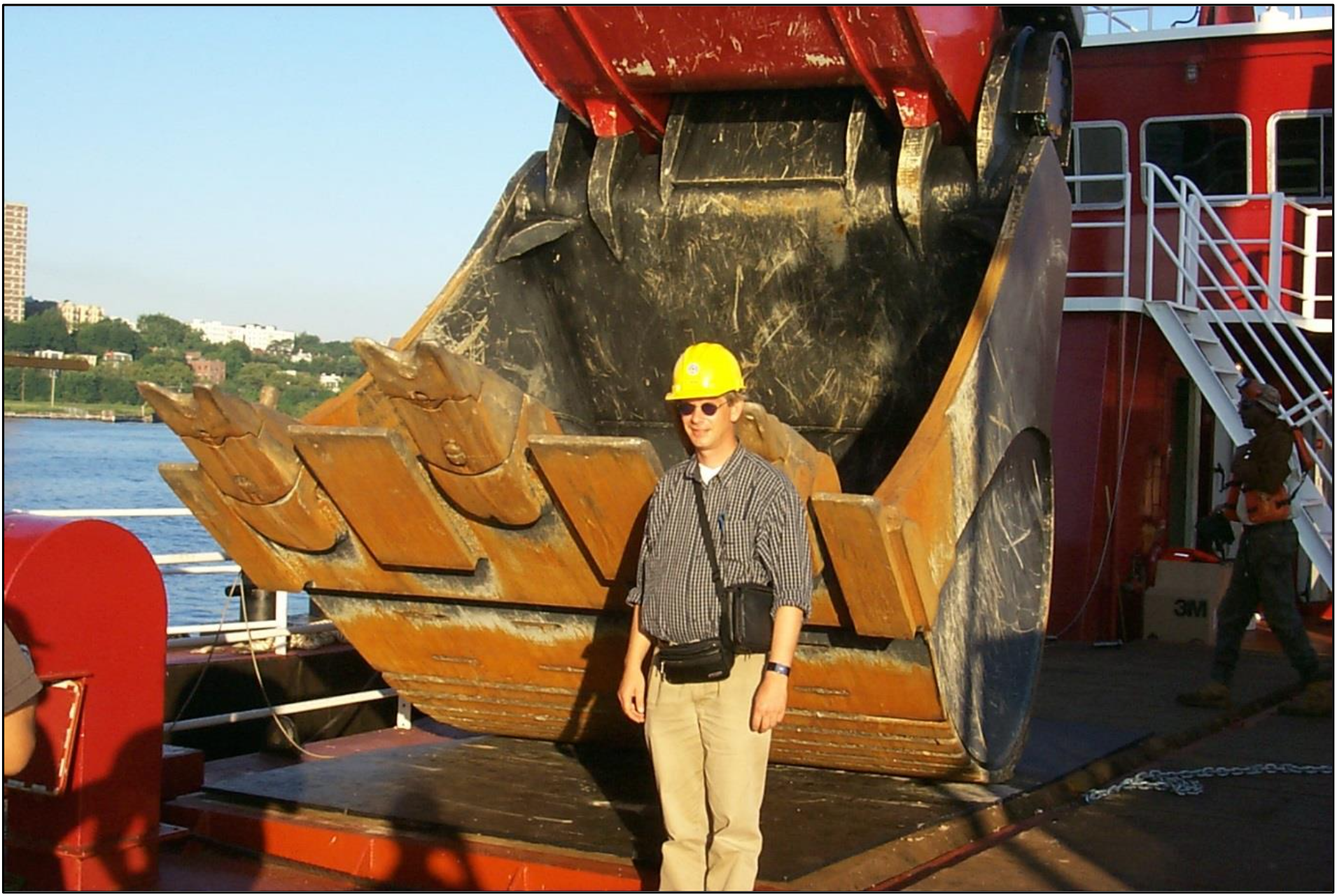1.1: Approach
- Page ID
- 29338
This book gives an overview of cutting theories for the cutting of sand, clay and rock as applied in dredging engineering. In dredging engineering in general sand, clay and rock are excavated with buckets of bucket ladder dredges, cutter heads of cutter suction dredges, dredging wheels of wheel dredges, drag heads of trailing suction hopper dredges, clamshells, backhoes and other devices. Usually the blades have a width much larger than the layer thickness of the cut (2D process) and the blade angles of these devices are not too large in the range of 30°- 60°. Although clamshells and backhoes may have blade angles around 90° when they start cutting. Other devices like drill bits of oil drilling devices, blades of tunnel boring machines, ice berg scour and the bull dozer effect in front of a drag head may have cutting angles larger than 90°. In such a case a different cutting mechanism is encountered, the so called wedge mechanism.
The book starts with some basic soil mechanics, the Mohr circle and active and passive soil failure in Chapter 2: Basic Soil Mechanics. These topics can also be found in any good soil mechanics book, but covering this makes the reader familiar with the use of the many trigonometrically equations and derivations as applied in the cutting theories.
A generic cutting theory for small blade angles is derived in Chapter 3: The General Cutting Process. This generic cutting theory assumes a 2D plane strain cutting process, where the failure lines are considered to be straight lines. The generic cutting theory takes all the possible forces into account. One can distinguish normal and friction forces, cohesive and adhesive forces, gravitational and inertial forces and pore vacuum pressure forces.
Six types of cutting mechanisms are distinguished; the Shear Type, the Flow Type, the Curling Type, the Tear Type, the Crushed Type and the Chip Type.
The Shear Type, the Flow Type and the Crushed Type are mathematically equivalent.
The Chip Type is a mix of the Shear Type and the Tear Type.
The generic theory also contains a chapter on the so called snow plough effect, a blade not perpendicular to the direction of the cutting velocity like a snow plough. Finally the methods for determining the shear plane angle and the specific energy are discussed.
In Chapter 4: Which Cutting Mechanism for Which Kind of Soil? it is discussed which terms in the generic equation are valid in which type of soil. A matrix is given to enable the reader to determine the terms and soil properties of influence.
The following chapters give the 2D theory of soil cutting with small blade angles that will enable the reader to determine the cutting forces, powers and production in different types of soil.
Dry sand cutting is dominated by gravitational and inertial forces and by the internal and external friction angles. The cutting mechanism is the Shear Type. This is covered in Chapter 5: Dry Sand Cutting.
Saturated sand cutting is dominated by pore vacuum pressure forces and by the internal and external friction angles. The cutting mechanism is the Shear Type. This is covered in Chapter 6: Saturated Sand Cutting.
Clay cutting is dominated by cohesive (internal shear strength) and adhesive (external shear strength) forces. The basic cutting mechanism is the Flow Type. Cutting a thin layer, combined with a high adhesive force may result in the Curling Type mechanism. Cutting a thick layer combined with a small adhesive force and a low tensile strength may result in the Tear Type mechanism. This is covered in Chapter 7: Clay Cutting.
Rock cutting under atmospheric conditions (normal dredging) is dominated by the internal shear strength and by the internal and external friction angles. The main cutting mechanism is the Chip Type a mix of the Shear Type and the Tear Type, brittle cutting. At small blade angles the pure Tear Type may occur, at large blade angle the pure Shear Type. Cutting a very thin layer or using large blade angles may result in the Crushed Type. This is covered in Chapter 8: Rock Cutting: Atmospheric Conditions.
Rock cutting under hyperbaric conditions (deep sea mining) is dominated by the internal shear strength, the pore vacuum pressure forces and by the internal and external friction angles. The main cutting mechanism is the Crushed Type, cataclastic semi-ductile cutting. This is covered in Chapter 9: Rock Cutting: Hyperbaric Conditions.

At large blade angles, the theory of the 2D cutting process at small blade angles can no longer be valid. This theory would give very large and even negative cutting forces which is physically impossible. The reason for this is a sine in the denominator of the generic cutting force equation containing the sum of the blade angle, the shear angle, the internal friction angle and the external friction angle. If the sum of these 4 angles approaches 180 degrees, the sine will become very small resulting in very high cutting forces. If the sum of these 4 angles exceeds 180 degrees, the sine is negative resulting in negative cutting forces. Nature will find another mechanism which is identified as the wedge mechanism. In front of the blade a wedge will occur, with an almost fixed wedge angle, reducing the cutting forces. Chapter 10: The Occurrence of a Wedge describes the generic theory for the occurrence of a wedge in front of the blade.
The following chapters give the theory of soil cutting at large blade angles that will enable the reader to determine the cutting forces, powers and production in different types of soil.
In dry sand cutting the blade angle, the shear angle, the internal friction angle and the external friction angle play a role. The issue of the sum of these 4 angles approaching or exceeding 180 degrees may occur for large blade angles. This is covered in Chapter 11: A Wedge in Dry Sand Cutting.
In saturated sand cutting the blade angle, the shear angle, the internal friction angle and the external friction angle play a role. The issue of the sum of these 4 angles approaching or exceeding 180 degrees may occur for large blade angles. This is covered in Chapter 12: A Wedge in Saturated Sand Cutting.
In clay cutting the blade angle and the shear angle play a role. The issue of the sum of these 4 angles approaching or exceeding 180 degrees may occur for very large blade angles, for example ice berg scour. This is covered in Chapter 13: A Wedge in Clay Cutting.
In atmospheric rock cutting the blade angle, the shear angle, the internal friction angle and the external friction angle play a role. The issue of the sum of these 4 angles approaching or exceeding 180 degrees may occur for large blade angles. This is covered in Chapter 14: A Wedge in Atmospheric Rock Cutting.
In hyperbaric rock cutting the blade angle, the shear angle, the internal friction angle and the external friction angle play a role. The issue of the sum of these 4 angles approaching or exceeding 180 degrees may occur for large blade angles. This is covered in Chapter 15: A Wedge in Hyperbaric Rock Cutting.
Appendix Y shows all the different equipment the theory can be applied to and Appendix Z gives a list of the publications this book is based on. It is the choice of the author to make each chapter self-containing, meaning that figures and basic equations may be repeated at the start of each chapter.
In the appendices many graphs, charts and tables are shown, much more than in the corresponding chapters, in order to give the reader all the information necessary to apply the theory in this book in a proper way.
Empty space and pages are filled with figures and photos illustrating different equipment for soil cutting.
The book is used for the MSc program of Offshore & Dredging Engineering at the Delft University of Technology.





